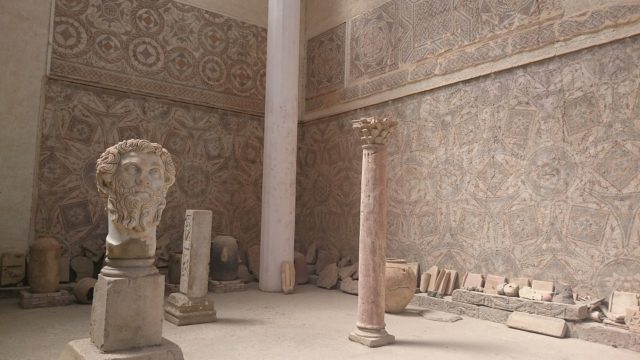Djémila, formerly Cuicul, is a small village in Algeria where people live side-by-side with the most well preserved Roman ruins in North Africa.
It is located 30 miles north-east of the city of Sétif, on a narrow plateau at an altitude of 3,000 feet. According to UNESCO, Cuicul “is one of the world’s most beautiful Roman ruins.”
Cuicul was built during the first century AD as a military garrison, under the orders of Emperor Nerva. It later grew into a large market town that expanded beyond the original defensive ramparts.
It is estimated that approximately 20,000 people lived in the town during its peak.

The town was large enough to have its own Senate and Forum. Out of the many buildings in ancient Cuicul, the most significant are the curia, which served as the town hall, and the central temple, or capitol.
Remnants of several more temples, as well as houses and other civic buildings, can also be seen.
One rather grand mansion dating from the 5th century, called the House of Bacchus, even has the remains of its two gardens and a fishpond.

Of course no Roman town would be complete without a public bathhouse. The baths at Djémila were built circa 183 AD, during the reign of Emperor Commodius. Many features are still remarkably intact.

Visitors can stroll along the two main streets: Cardo Maximus, which has gates at each end, and the Decumanus Maximus.
These composed the principal axes of the town layout. Despite the difficult terrain, the builders of Cuicul managed to follow a classic Roman street plan.

One of the best-known markets in the town was that of the Cosinus brothers, which is evidence of the economic growth and prosperity of the ancient town.
Inside the Market of Cosinius it almost seems as though the Roman traders are about to arrive to start trading for the day. Tables still line the walls, which are decorated with beautiful carvings.
Lonely Planet informs us that “Also here is a carved stone that shows how weights and measures were checked.”
Underneath the market is the town jail — surprisingly, this is in good enough condition for tourists to explore.

During the reign of Caracalla (r. 198-217) the town expanded beyond its original walls, some of which were removed.
Among the structures from this period are the theater with a capacity of 3,000 people, and the 40-feet-tall Arch of Caracalla. This served as the town’s west gate, facing the road to Sétif.
A number of mosaics that have been uncovered during archaeological excavations have undergone restoration. These are mostly displayed in the museum; the only one in Algeria with its walls entirely covered with mosaics.
The basilica and the baptistery were constructed in the 4th century when Christianity became popular in the area.

They are located to the south of Cuicul and today are popular attractions in the area known as the Christian Quarter.
The location of the town is fascinating because of its buildings and the way that they have been integrated into the mountain landscape.
However, Djémila is under a lot of threats today from fire, earthquake, thieves, vandals, and illegal construction.

During the late-5th century and 6th century, after the fall of the Roman Empire, Cuicul was slowly abandoned.
Later, Muslims dominated the region and renamed the ancient town of Cuicul as Djémila, which means beautiful in Arabic.
Because of its unique style of Roman architecture adapted to a mountain environment, in 1982, Djémila became a UNESCO World Heritage Site. Today, Djémila stands out as one of the best-preserved Roman ruins of North Africa.
